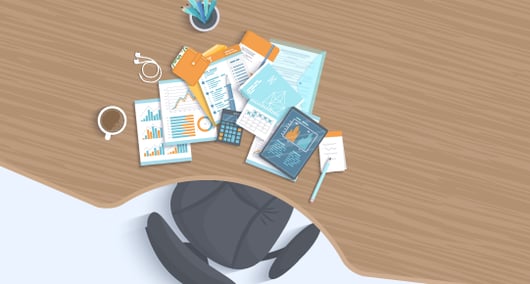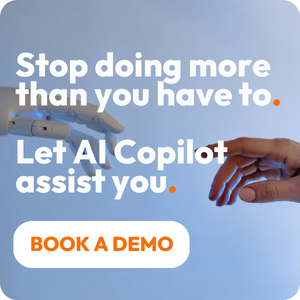Share this
The Multitasking Myth: The Switch Cost
by Catherine Rozyczko on April 22, 2020

In our followup to The Multitasking Myth, we delve more deeply into the switch cost, i.e. the deficit of mental energy it takes when making a ‘switch’ to another task.
The switch cost is just one of the reasons that multitasking, in terms of productivity and optimal cognitive functioning, is something you want to minimize as much as you can —
Both in your personal working habits and in those of your team members.
We’ll talk briefly about the science behind the switch cost and what it could be costing you and your organization.
You can also check out our checklist to see how you can lower your switch cost, reduce multitasking, and optimize your organization’s time and energy.
The Switch Cost
It’s not just SaaS companies obsessed with efficiency that are interested in the switch cost.
A boatload of research has been done into what the multitasking switch cost means and what it really ‘costs’ by people in various fields of study.
And it’s pretty interesting stuff:
In the mid-1990s, Robert Rogers, PhD, and Stephen Monsell, D.Phil, found that even when people had to switch completely predictably between two tasks every two or four trials, they were still slower on task-switch than on task-repeat trials. Moreover, increasing the time available between trials for preparation reduced but did not eliminate the cost of switching….
To determine the costs of this kind of mental "juggling," psychologists conduct task-switching experiments. By comparing how long it takes for people to get everything done, the psychologists can measure the cost in time for switching tasks. They also assess how different aspects of the tasks, such as complexity or familiarity, affect any extra time cost of switching.
Source: American Psychological Association Multitasking: Switching Costs
"In a nutshell, the switch cost is real and can be measured quantitatively."
And the body of research on the switch cost proves two important points:
1) The switch cost eats up time.
In experiments conducted by researchers from psychologists to neurologists, the switch cost has been shown to eat up time. And even though switch costs can be really small (like fractions of a second), they can add up easily to a significant amount of time, even in just one day.
2) The switch cost eats up brainpower.
It’s harder for multitaskers to organize their memories or filter out irrelevant information, according to this study. Plus, there is much more documented evidence of multitasking leading to negative cognitive outcomes. Every time the brain multitasks — versus focusing on one objective at a time — brainpower goes down in the form of IQ, EQ, and more.
How much is the switch cost costing you?
Now that you understand the deficit caused by the switch cost and multitasking at large, here’s how you can figure out how much the switch cost could be costing you. Take the following inventory:
1) Personally- Take a good hard look at your personal day-to-day workflow. How much of that time is spent multitasking? Checking phone notifications? Switching browser tabs to quickly check email?2) Technically- How many platforms do you use on a daily basis to conduct business? Five? Seven? How often do you bounce between these platforms: twice per hour? 10 times? How many of these platforms are integrated with one another? Be thinking about what could possibly be automated.
3) At the organizational level- Do you encourage multitasking among team members? Are people (yourself included) perpetuating the multitasking myth?
How to minimize the switch cost
After you answer those questions and get an understanding of where your business —
be it a one-man show or team environment — stands from an efficiency standpoint, you can take action in each area to get the switch cost down.
1) Personally- Eliminate potential distractions with forcing functions, i.e. keeping your cell in another room while working on a project. Automate important notifications to come to your desktop, so you can see important messages while filtering out what’s not pertinent to your daily workflow. This is just one example, but the idea is this —"The less will power you need to use NOT to indulge in distraction, the better."
2) Technically- Minimize bouncing back and forth between platforms as much as humanly possible by using really comprehensive software solutions like Microsoft Teams and HubSpot, to name a couple. When looking at different environments to minimize your multitasking, look for self-driving features and
Integrations, integrations, integrations.
"The more your platforms can talk to one another, the less mindless work and multitasking you and your team members need to do."
3) At the organizational level- Create a culture around efficiency and brainpower. Make it clear that everyone’s time has value, and the more each person can do with it, the better off every team member will be. With this attitude in mind, adopt different strategies and solutions that can minimize multitasking and get people focused on one objective at a time.
"The science is clear that focusing on one objective at a teime is optimal for your brain, and getting people onboard will go a long way by productivity."
Share this
- Project Management (101)
- Productivity (63)
- Time Tracking (27)
- PSA Software (26)
- HubSpot (20)
- Resource Management (15)
- Invoicing (12)
- Salesforce (11)
- AI (10)
- Profitability (8)
- Contract Management (7)
- collaboration (5)
- Gantt Chart (4)
- Microsoft Dynamics (4)
- Budget Management (3)
- Consultancy (3)
- Financial services (3)
- Integrations (3)
- Quickbooks (3)
- Quote (3)
- ROI (3)
- Traffic Management (3)
- About PSOhub (2)
- Automation (2)
- Digital Marketing & Advertising (2)
- Pipedrive (2)
- Work Management (2)
- IT Companies (1)
- Product (1)
- Risk Management (1)
- Task Management (1)
- Ticket Sync (1)
- Workload Management (1)
- power bi (1)
- December 2025 (2)
- November 2025 (3)
- October 2025 (2)
- September 2025 (1)
- August 2025 (1)
- July 2025 (4)
- June 2025 (1)
- May 2025 (5)
- April 2025 (4)
- March 2025 (3)
- February 2025 (3)
- January 2025 (3)
- December 2024 (1)
- November 2024 (5)
- October 2024 (5)
- September 2024 (1)
- August 2024 (4)
- July 2024 (3)
- June 2024 (5)
- May 2024 (4)
- April 2024 (5)
- March 2024 (5)
- February 2024 (4)
- January 2024 (3)
- December 2023 (2)
- November 2023 (6)
- October 2023 (5)
- August 2023 (6)
- July 2023 (2)
- June 2023 (4)
- May 2023 (4)
- April 2023 (3)
- March 2023 (4)
- February 2023 (4)
- January 2023 (3)
- December 2022 (5)
- November 2022 (3)
- October 2022 (4)
- September 2022 (5)
- August 2022 (7)
- July 2022 (1)
- June 2022 (7)
- May 2022 (6)
- April 2022 (2)
- March 2022 (2)
- February 2022 (4)
- January 2022 (4)
- December 2021 (5)
- November 2021 (2)
- October 2021 (2)
- September 2021 (3)
- August 2021 (3)
- July 2021 (2)
- June 2021 (2)
- May 2021 (3)
- April 2021 (2)
- March 2021 (2)
- February 2021 (3)
- January 2021 (5)
- December 2020 (4)
- November 2020 (2)
- October 2020 (4)
- September 2020 (5)
- August 2020 (4)
- July 2020 (4)
- June 2020 (1)
- May 2020 (4)
- April 2020 (8)
- March 2020 (7)
- January 1970 (1)


